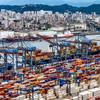BIMCO: What Shipping Market can Expect for 2017
The shipping market in 2016 and looking forward
The shipping industry has its work cut out going forward in 2017 as the International Monetary Fund (IMF) forecast the lowest level of global GDP growth since 2009. 2017 will see another year of die-hard competition, which now includes tankers. In 2016, the container shipping industry bit the bullet in terms of demolition and consolidation to help the market to recover. The dry bulk sector needs to copy that approach.
Global economy: not lending shipping a hand
The longer global economic growth remains weak and lacks investment, the lower future growth potential for shipping.
For eight years, the world has struggled to cope with huge changes and challenges brought around by the crash of the financial market in 2008. The resulting issues have not always been dealt with in the best way, leaving many large economies still in ‘recovery’ mode.
The full restoration of shipping markets will need several years of solid improvements to lift fleet utilisation rates. Sector overcapacity almost everywhere must be reduced. Government support for any industry – including shipping – which is feeling the heat of global competition might seem like a good thing. But direct subsidies from governments in fact have a negative impact on the global shipping industry as they affect free trade and undermine the level playing field for businesses.
In pure economic terms, 2016 has seen Europe improving, the US stagnating and Japan at a standstill. So, we have not seen much global change aside from some interregional trade flows and there has been no real growth of demand on a broader scale.
In shipping, we rely on global imbalances in raw materials, energy and manufacturing facilities. Regardless of reported statistics of economic growth being right or wrong, China remained at the centre of shipping imports and exports in 2016.
Will the world grow its GDP in 2017 in a way that will benefit shipping? Probably not, as global GDP growth is currently driven by service sectors and developing/emerging economies which result in a lower “GDP-to-trade multiplier”, and thus generate a lower level of shipping demand than we have been accustomed to in the past.
Dry bulk: worst year on record - heavy demolition activity needed to relieve the pain
2016 has been a horrible year for the dry bulk shipping industry. After the Baltic Dry Index (BDI) reached an all-time-low of 290 on 10 February, it improved steadily throughout the year to peak in mid-November at 1,261. This was driven by and benefitted mainly the capesize ships as they transported the key commodities of iron ore into China. As the year progressed, the situation eased as demand growth outstripped the impact of the net supply growth of the fleet.
Chinese steel mills grew production and kept on substituting domestically mined ore with imported ore. Additionally, the reduction in operational days at Chinese coal mines reversed the declining trend for coal imports, adding much needed tonne-miles to the demand side.
In May, BIMCO provided industry leadership with some new and unique market analysis on the “Road to Recovery” for dry bulk. This analysis identified what the shipowners must do to return to profitability in 2019. Scrapping ships and refraining from building new ships is essential as we can’t expect the same levels of demand growth as we have experienced in the past.
For 2017, it is vitally important that shipowners handle the supply side of the market with great care. A continuance of the alarmingly low level of demolition activity in the second half of 2016 simply will not deliver the needed zero fleet growth. A significant number of new ships are on order for 2017 and 2018. The only way to neutralise the impact of this influx of new ships will be to scrap 30 million DWT annually. This is not a tall order in theory, but the slowdown in scrapping seen since June 2016 causes alarm bells to ring. BIMCO expects the supply-side to grow by around 1.6% in 2017 (2.2% in 2016E).
Tanker: reversal of fortune after a perfect year
In the wake of a very strong 2015, fortune faded as expected for crude oil and oil product tankers. A strong freight market was created by an increased throughput at global refineries causing up-front oil demand to run ahead of end-consumption and a moderate supply side growth for crude oil tankers. In 2016 the fleet grew by 6% for both tanker segments. This unbalanced the market because demand growth eased off. BIMCO suggests that in coming years the end-consumption of oil will need to catch up – and bloated oil stocks must be drawn on – before the market can be rebalanced.
Global oil supply continued to grow in 2016 despite many disruptions to production in key exporting countries. The re-entry of Iran into international oil stood as the single-most disruptive event to an established oil market and it had a knock-on effect into the tanker market. Whether the changes to trade patterns end up benefitting the tanker market remains to be seen and depends on the West African exporters’ ability to defend their market shares in Asia, particularly in India.
Tanker demand growth in 2017 is expected to come predominantly from the greater Asian region led by China and India.
BIMCO expects the crude oil tanker segment to see a net fleet growth of around 3% in 2017 (6.0% in 2016E). We estimate the supply side growth rate of the oil product tanker fleet to be around 2.5% (6.1% in 2016E). We foresee demolition of tanker capacity to reach a five-year high, but not enough to prevent the onset of a loss-making freight market.
Showing leadership to the global shipping industry, in 2017 BIMCO will continue its unique series of analysis on the “Road to Recovery” for the crude oil tanker market, following the analysis published in 2016 on what is needed for the dry bulk sector to recover.
Container: fundamental market balance improved as demolition went through the roof
After deteriorating market conditions in 2015, with a very high fleet growth and a sensationally high number of new orders for future delivery, 2016 got off to a bad start. The need to match the supply of container shipping capacity with global demand for containerised goods became even more urgent.
How did the container shipping industry act in this “self-inflicted” shipping market crisis? By using some tools that had seemingly been forgotten. Many operational tools have been successfully applied in the market already (slow-steaming and idling), leaving the non-operational tools to be put into action in 2016 (limiting new orders, scrapping and consolidation).
2016 stands out in terms of consolidation, both in the form of outright mergers but also in the newer and larger alliances being forged to cut cost. We also saw the unprecedented event of a government-sponsored shipowner filing for court protection.
Additionally, the very low number of newbuilding orders was backed up by an all-time high of demolition capacity reducing the harmful effects of new ships being delivered. Panamax ships went out of fashion, resulting in further value erosion of the ship size that turned out to be the one which was squeezed out between the feeders and the very large ships.
Generally, the container shipping industry has found it difficult to adapt to the new normal where demand grows by a multiple of global GDP growth of one or even below, unlike the multiplier of two or more experienced year on year in the past. Nevertheless, market conditions ended up improving in 2016 as fleet growth was lower than demand growth, the first time since 2010.
BIMCO expects the container shipping segment to see a net fleet growth of around 3.1% in 2017 (1.1% in 2016E). If the multiplier gets back to one, and the IMF forecast of 3.4% becomes reality, the market will neither improve or worsen in 2017.












